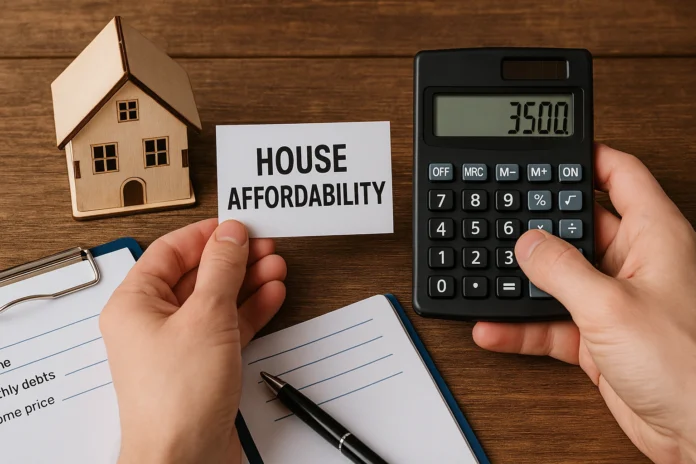The journey to homeownership often begins with a simple question: “How much house can I afford?” You visit a calculator, plug in your numbers, and get an answer. But what if that answer feels… limiting? What if the home you dream of seems just out of reach?
This is the moment where many prospective buyers feel discouraged. They see their affordability as a fixed, unchangeable number. But the truth is, your home buying power isn’t set in stone. It’s a dynamic figure that you can actively shape and improve. It’s a financial muscle that, with the right strategy, you can strengthen significantly.
This guide is your training plan. We are moving beyond the simple “what” of an affordability calculator and diving deep into the “how.” How can you become the strongest possible home buyer? How can you confidently walk into a lender’s office knowing you’ve maximized your potential? Let’s unlock your true home buying power.
What Lenders Really See: The Three Pillars of Your Buying Power
When a mortgage lender assesses your application, they aren’t just looking at your salary. They are evaluating your overall financial health through a lens focused on three core pillars. Mastering these pillars is the key to unlocking a better mortgage and a better home.
- Your Income & Employment: This is your financial engine. Lenders need to see stable, verifiable income that can comfortably support a mortgage payment.
- Your Debts & DTI Ratio: This is your financial drag. It measures how much of your income is already spoken for by other debts.
- Your Credit & Payment History: This is your financial track record. It tells lenders how reliably you’ve managed debt in the past.
Let’s break down each pillar and outline the actionable steps you can take to fortify it.
Beyond the Percentage: A Practical Guide to Your DTI Ratio
Of the three pillars, your Debt-to-Income (DTI) ratio is arguably the most critical and the one you have the most immediate control over. It’s the simple percentage of your gross monthly income that goes toward paying your monthly debt obligations.
Front-End vs. Back-End: The Two Sides of the DTI Coin
Lenders look at two types of DTI:
- Front-End DTI (Housing Ratio): This calculates how much of your income your new housing payment (PITI – Principal, Interest, Taxes, Insurance) would consume. Lenders traditionally like to see this number at or below 28%.
- Back-End DTI (Total Debt Ratio): This is the all-important number. It includes your future PITI plus all your other existing monthly debts: car payments, student loans, credit card minimums, etc. The gold standard for lenders is a back-end DTI at or below 36%.
While some loan programs may stretch to 43% or even higher, a lower DTI makes you a much more attractive borrower and directly increases how much you can afford.
Actionable Strategy: How to Lower Your DTI and Boost Your Budget
If your DTI is higher than you’d like, focus on these steps in the months leading up to your home search:
- Attack High-Interest Debt: Credit card balances are a DTI killer. Focus on aggressively paying down cards with the highest interest rates. Every dollar of monthly minimum payment you eliminate is a dollar that can be reallocated to your future housing payment.
- Hold Off on New Debt: The months before buying a home are not the time to finance a new car or furniture. Avoid any new loans or credit inquiries that would add another monthly payment to your back-end DTI.
- Consider Paying Off Small Loans: Do you have a small personal loan with less than 10 months remaining? Some lenders may be able to ignore it, but paying it off entirely removes any ambiguity and cleans up your debt profile.
Your Credit Score: The “Interest Rate Lever” You Control
Your credit score is more than just a three-digit number; it’s the primary lever that controls the interest rate you’ll be offered. A higher score signals to lenders that you are a low-risk borrower, and they reward that with a lower rate.
Why a Few Points Can Mean Thousands of Dollars
This may be the most underestimated factor in home affordability. Consider a $350,000 home loan on a 30-year fixed mortgage:
- A borrower with an excellent credit score (760+) might get an interest rate of 6.5%. Their monthly principal and interest payment would be approximately $2,212.
- A borrower with an average credit score (660) might get an interest rate of 7.5%. Their monthly principal and interest payment would be approximately $2,447.
That $235 per month difference adds up to $2,820 per year and a staggering $84,600 over the life of the loan. More importantly, that lower monthly payment means you have more room in your DTI calculation, directly increasing your home buying power.
Pro-Tips for Polishing Your Credit Before Applying
- Always Pay on Time: Your payment history is the single biggest factor in your score. Set up automatic payments to ensure you never miss a due date.
- Lower Your Credit Utilization: Aim to use less than 30% of your available credit on each card. If you have a card with a $10,000 limit, try to keep the balance below $3,000.
- Review Your Credit Reports: Get free copies of your reports from all three bureaus (Equifax, Experian, TransUnion) and dispute any errors you find. A simple mistake could be costing you valuable points.
Your Down Payment: More Than Just an Entry Fee
Your down payment is the ultimate affordability accelerator. Every dollar you contribute upfront is a dollar you don’t have to borrow, which has a powerful ripple effect across your entire mortgage.
The PMI Hurdle: How 20% Down Unlocks Lower Payments
When you put down less than 20% on a conventional loan, lenders require you to pay Private Mortgage Insurance (PMI). This is an insurance policy that protects the lender if you default, and it offers no benefit to you. PMI can add $100 to $300 (or more) to your monthly payment, significantly impacting your affordability.
Saving for a 20% down payment is the single best way to eliminate this extra cost and lower your monthly housing expense from day one.
Creative Down Payment Strategies
If 20% feels out of reach, don’t despair. Explore these options:
- Down Payment Assistance (DPA) Programs: Many states and cities offer grants or low-interest loans to help first-time homebuyers with their down payment and closing costs.
- Gift Funds: Lenders often allow you to use money gifted from a close family member for your down payment, provided it’s properly documented with a gift letter.
- Low Down Payment Loans: FHA loans (3.5% down) and VA loans (0% down for eligible veterans) are excellent alternatives, though they come with their own forms of mortgage insurance.
From Theory to Action: Your Pre-Approval Game Plan
Understanding these pillars is the first step. The next is to prove your buying power to lenders and sellers through pre-approval. Note the difference:
- Pre-qualification is a quick, informal estimate of what you might be able to borrow based on self-reported information.
- Pre-approval is a serious commitment. You provide a lender with your pay stubs, bank statements, and tax returns. They verify your income, pull your credit, and give you a conditional commitment for a specific loan amount.
A pre-approval letter transforms you from a window shopper into a serious contender. It shows real estate agents and sellers that you are a credible buyer who can close the deal. Your game plan should be to work on your DTI, credit, and savings for 3-6 months, then use a tool like our House Affordability Calculator to set a realistic target before approaching a lender for a formal pre-approval.
Conclusion: Build Your Buying Power
Your ability to buy a home is not a lottery ticket; it’s a construction project. You are the architect. By strategically paying down debt, diligently monitoring your credit, and creatively saving for a down payment, you lay a foundation of financial strength. You take control of the variables that matter most.
Stop asking only “what can I afford?” and start asking “how can I improve what I can afford?” The answer lies in the disciplined, focused effort you put in today. Build your buying power, and you won’t just buy a house—you’ll make a sound, confident, and life-changing investment.


